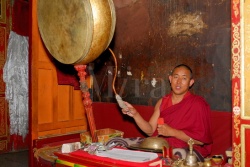Fahaisi
Fahaisi (法海寺)
The construction of Fahaisi took five years and was completed in 1443AD under the patronage of an influential eunuch Li Tong. The temple is located on Mount Cuiwei in the Shijingshan district in the western suburbs of Beijing which was the capital of both the Yuan and Ming dynasties. Since the Yingshan Bureau of Ministory of Public Works (Yingshansuofu) was associated with construction of the temple, it resembled other official constructions and is believed to have had some importance in the court. It is possible that Fahaisi may have been built as a shengsi, a temple used to perform memorial rites for eunuchs who did not have any family members to do so after their passing. Much of the temple was destroyed during the Cultural Revolution but the remains suggests that the temple was constructed in the classic Chinese template imitating the construction of the Chinese imperial palace which had the buildings arranged on a central axis, sitting north and facing south. Construction of the Fahaisi began in 1439, the 4th year of Ming Emperor Zhengtong's reign, by the Board of Works on the ruins of Longquansi (Temple of Dragon-Spring). Funds were raised by Li Tong, a favorite official eunuch of the Ming Emperor Yingzong.
The importance of the temple lies in its close ties with Tibetan Buddhism and the use of Tibetan imagery on the walls of the temple. Since Li Tong served as the Director of Imperial Accoutrements for the Yongle and Zhengtong Emperors, he was influenced by his patrons’ interest and their devotion to Tibetan Buddhism which was evident in their great displays of religious rituals and meetings with Tibetan clerics. He also had direct access and control of the building of the temple and there was strong evidence of his own personal following of the Buddhist cult. Only the Mahavira Hall survived the Cultural Revolution, and it can be divided into 3 basic sections. Flanking the sides of the north wall are Indra and Brahma dressed in typical Ming Court attire at a royal procession. The side walls were painted with the Buddhas of the Ten Directions and their eight bodhisattva attendants floating above a royal garden, which served as the background for the sculptures of the Eighteen Arhats. On three panels at the back of the rear alter screen are paintings of Water-moon Guanyin, Samantabhadra and Manjusri, all of which were common themes used during the construction of Ming temples. Moreover, usage of certain techniques such as the placement of figures and the re-use of common forms imply a court workshop production. From photos before the revolution, the eighteen Arhats were once lined in the east and west walls of Mahavira Hall and a wooden Mahakala statue was placed among them. The Mahakala statue was the protector of the Yuan dynasty and one of the important deities in the pantheon of gods within Tibetan Buddhism. The ceiling have 3 large mandala, located at the center is Vairocana, to the right, Bhaisajyaguru, and to the left, Amitabha. These are all linked to Tibetan mortuary liturgy and artistically reflect a Newar- Tibetal model.
The FaHaiSi Temple might be one of the oldest temples in Qingdao. According to locals it's "The most ancient" Buddhist temple. It is located in the Summer Village Town of Mount Lao and was built in the period of Emperor WeiWu, which dates back to approximately 1,700 years ago. In the early years of the 1980's, a great deal of stone-carved statues from the North Dynasty were found 20 meters outside the temple. These valuable unearthed relics had been under the earth for more than 1,000 years and can be viewed the Qingdao Municipal Museum'
Source:
Karl Debreczeny. Sino-Tibetan Artistic Synthesis in Ming Dynasty Temples. Tibet Journal. 28: 49-107.
Entry by ShiQi Wu, 26th Feb 2007
